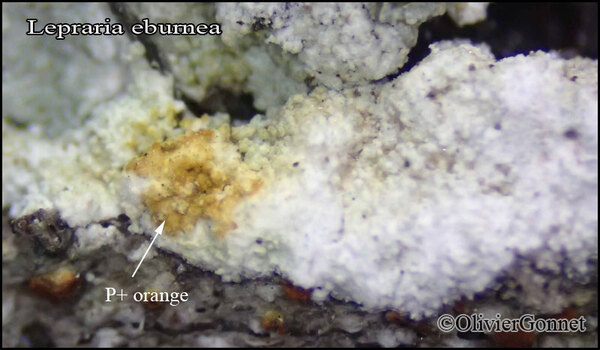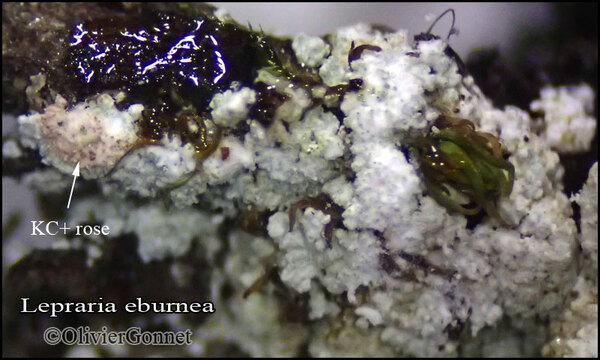Lepraria eburnea J.R. Laundon
Lichenologist, 24: 331, 1992.
Synonyms: Lepraria frigida J.R. Laundon
Description: Thallus leprose, cottony, whitish to greenish grey, often with a yellowish tinge, 0.2-0.5 mm thick, sharply delimited, orbicular at least when young, usually without marginal lobes, but sometimes weakly sublobate, consisting of a mass of powdery, spherical, (22-)33-70(-150) µm thick granules with up to c. 40 µm long, protruding, but never clam-shaped hyphae. Medulla white, not always evident, UV+ violet, the hyphae 2-4.5 µm thick, covered in small colourless crystals. The thallus stains herbarium paper red-brown after some years due to the presence of alectorialic acid. Photobiont chlorococcoid, the cells up to 20 µm diam. Spot tests: K- or K+ yellowish, C+ faintly yellow or pink, KC+ pink to reddish orange (reaction sometimes ephemeral), P+ yellow slowly turning orange or P+ rapidly orange, UV-. Chemistry: three chemotypes: 1) alectorialic acid only, 2) alectorialic and protocetraric acids, 3) alectorialic and psoromic acids.
Growth form: Leprose
Photobiont: green algae other than Trentepohlia
Reproductive strategy: mainly asexual, by soredia, or soredia-like structures (e.g. blastidia)
In underhangs rarely wetted by rain
Commonnes-rarity: (info)
Alpine belt: absent
Subalpine belt: absent
Montane belt: rather common
Dry submediterranean belt: common
Humid submediterranean belt: very rare
Padanian area: rather common
pH of the substrata:
1 2 3 4 5
Solar irradiation:
1 2 3 4 5
Aridity:
1 2 3 4 5
Eutrophication:
1 2 3 4 5
Poleotolerance:
0 1 2 3
Altitudinal distribution:
1 2 3 4 5 6
Rarity
absent
extremely rare
very rare
rare
rather rare
rather common
common
very common
extremely common
Loading data...
Occurrence data
Predictive map
 Current prediction (1981-2010)
Current prediction (1981-2010)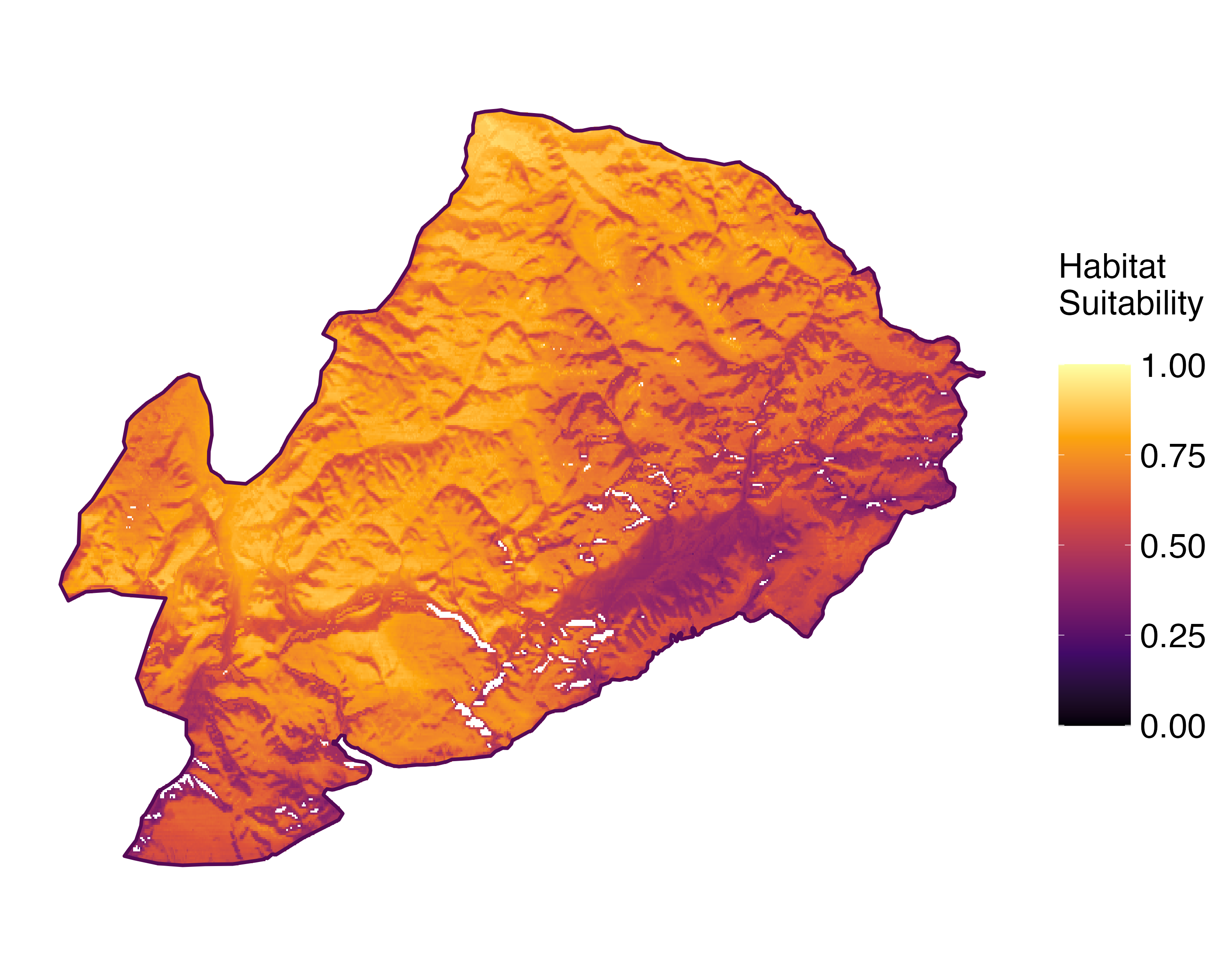 Future prediction (2071-2100) SSP 1-2.6
Future prediction (2071-2100) SSP 1-2.6 Future prediction (2071-2100) SSP 5-8.5Predictive maps according to Francesconi et al. 2025
Future prediction (2071-2100) SSP 5-8.5Predictive maps according to Francesconi et al. 2025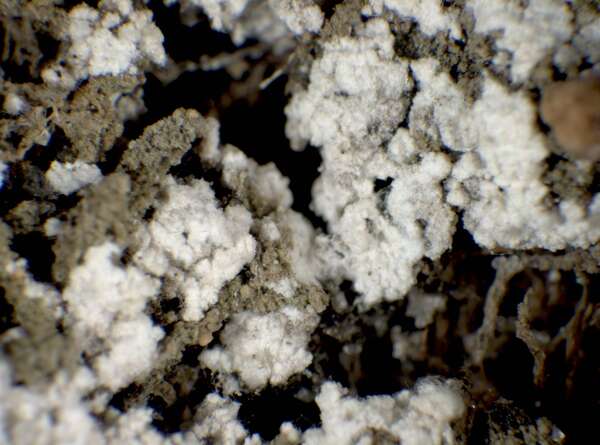
P.L. Nimis; Owner: Department of Life Sciences, University of Trieste
Herbarium: TSB (32753)
2001/12/13
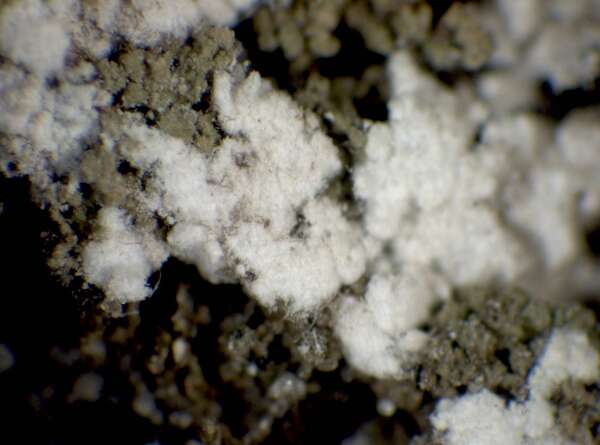
P.L. Nimis; Owner: Department of Life Sciences, University of Trieste
Herbarium: TSB (32753)
2001/12/13
Growth form: Leprose
Photobiont: green algae other than Trentepohlia
Reproductive strategy: mainly asexual, by soredia, or soredia-like structures (e.g. blastidia)
In underhangs rarely wetted by rain
Commonnes-rarity: (info)
Alpine belt: absent
Subalpine belt: absent
Montane belt: rather common
Dry submediterranean belt: common
Humid submediterranean belt: very rare
Padanian area: rather common
pH of the substrata:
| 1 | 2 | 3 | 4 | 5 |
Solar irradiation:
| 1 | 2 | 3 | 4 | 5 |
Aridity:
| 1 | 2 | 3 | 4 | 5 |
Eutrophication:
| 1 | 2 | 3 | 4 | 5 |
Poleotolerance:
| 0 | 1 | 2 | 3 |
Altitudinal distribution:
| 1 | 2 | 3 | 4 | 5 | 6 |
Rarity
absent
extremely rare
very rare
rare
rather rare
rather common
common
very common
extremely common
Loading data...
Occurrence data
Predictive map
 Current prediction (1981-2010)
Current prediction (1981-2010) Future prediction (2071-2100) SSP 1-2.6
Future prediction (2071-2100) SSP 1-2.6 Future prediction (2071-2100) SSP 5-8.5
Future prediction (2071-2100) SSP 5-8.5Predictive maps according to Francesconi et al. 2025

P.L. Nimis; Owner: Department of Life Sciences, University of Trieste
Herbarium: TSB (32753)
2001/12/13



